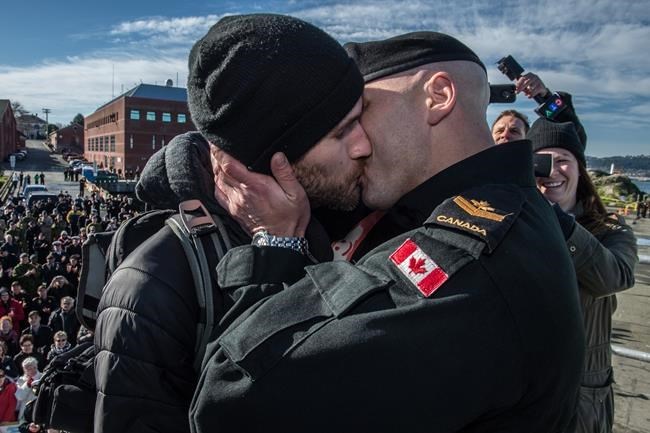OTTAWA — Trust.
Capt. Kirk Sullivan is talking about running what has become one of the most talked-about Twitter accounts in the federal government.
In particular, he is explaining why he doesn’t have to get approval before posting his tweets online.
That includes an instantly famous tweet with a picture of a Canadian sailor and his male partner kissing in February 2016 with the words #ProudBoys and pictures of Canadian and Pride flags.
The tweet garnered worldwide attention — and countless accolades — by touting the Canadian military’s policy of welcoming LGBTQ members while trolling the right-wing Proud Boys group.
"I have the trust of my leadership," Sullivan says, "which is invaluable, and I'm humbled and appreciate it."
Sullivan has been running the "Canadian Forces in the U.S." Twitter account from Canada’s embassy in Washington since June 2018.
Since then, he has raised the number of followers from 600 to more than 54,000 with a deeply personal and engaging approach absent from most federal accounts.
Like a soldier preparing for a mission, he talks about the need to understand his surroundings as well as his rules of engagement.
And, like a soldier worried about putting his foot on a mine, Sullivan knows the risks of a poorly placed tweet.
"It's unnerving most of the time for me," he says. "But I guess I believe in it to the point where I try to get over my own nervousness about consequences on me, personally, and actually go do this. Because it's clearly important. It matters to people. It matters to me."
Sullivan says he has been a "consumer" of Twitter since 2009, but it’s more than that: the public affairs officer from tiny Calvert, N.L., has immersed himself in the online world.
"If I'm pulled away from the account or Twitter for work or personal reasons for any amount of time, it takes me quite some time to get back up to speed with what's going on before I feel comfortable being active on the account," he says.
That situational awareness, which isn’t much different from soldiers trying to understand where they are operating, is readily apparent to Andrea Lane, an assistant professor at the Canadian Forces College who has researched military use of social media.
The Proud Boys tweet is a case in point of how Sullivan is what Lane describes as Extremely Online.
"He was so embedded in the Twitter atmosphere and environment that he knew that that was going on even before I did," says Lane. "And I'm on Twitter way more than I should be."
Sullivan also works hard to understand the political environment in which the Twitter account operates.
The movement on Twitter to "take back" the term "Proud Boys" from the right-wing group, by using the hashtag on photos of happy gay men together, came less than a week after President Donald Trump wouldn't condemn the organization in a debate.
That timing prompted some raised eyebrows about Sullivan’s tweet on Oct. 4.
The tweet was a risk, says Stephen Saideman, Paterson chair in international affairs at Carleton University, but "the way it's on the right side of the line is it doesn't mention Trump."
Though Trump failed to condemn the Proud Boys during the debate with Democratic challenger Joe Biden on Sept. 29, Sullivan notes the president came out against the group several days later.
At the same time, Sullivan saw an opportunity to highlight two key objectives for the Canadian military: eliminating discrimination and hate in the ranks and increasing diversity, including by proudly accepting members of Canada’s LGBTQ community.
"I don't think we should be ambiguous about these things," he says. "And we're not. Our leadership isn't. So it's kind of threading the needle of that opportunity."
With all the boxes ticked, Sullivan posted. Ten days later, the tweet has been shared 41,000 times and liked 265,000 times.
Sullivan’s other tweets range from discussions about pineapple on pizza to remembrances of Canadian and U.S. soldiers who have died.
There are also expressions of homesickness and posts both celebrating Canada and recalling darker parts of the country’s history, such as racism against Indigenous and Black people.
The personal voice contrasts with most other Canadian Armed Forces social-media accounts, which often focus on operations, equipment and announcements.
Sullivan denies the voice is his. Rather, he says he tries to reflect all Canadians — no matter their background — in the same way he represents the country when he puts on his uniform.
"I think people would be really disappointed if they met me in person and thought they were meeting 'CAF in U.S.,'" he says. "I don't think it's appropriate for the account to reflect me solely."
The account is popular in Ottawa, with Conservative Leader Erin O’Toole, Defence Minister Harjit Sajjan and chief of the defence staff Gen. Jonathan Vance among those who follow it.
It has also been welcomed by veterans like Alex Ruff, who served 25 years in the Forces and is now a Conservative MP, who says it puts a human face on the Canadian military.
It’s hard to gauge how much impact Sullivan has had in reminding Americans about the close military ties between Canada and the U.S., says Christopher Sands, director of the Canada Institute at the Woodrow Wilson Center in Washington, D.C.
But Sands says anecdotal evidence suggests Sullivan has had more success reaching certain segments of the U.S. population than an expensive public-relations campaign conducted by the Canadian Embassy several years ago.
"I think it's reaching an audience of Americans who care about the Canadian Forces and have a fondness for Canadians," Sands says. "And it kind of serves as a useful reminder of those relationships which underpin the military alliance and are really important."
This report by The Canadian Press was first published Oct. 15, 2020.
Lee Berthiaume, The Canadian Press



